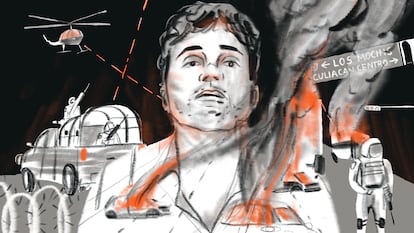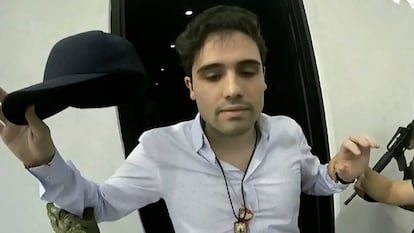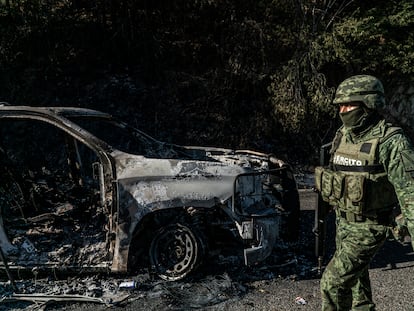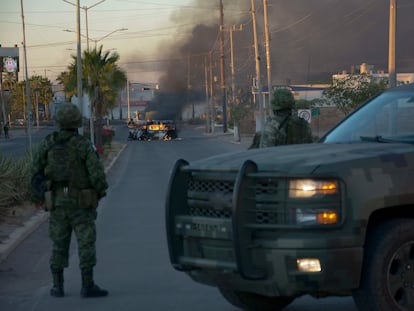Ovidio Guzmán, the kid who always wanted to become a narco
The son of drug lord Joaquín ‘El Chapo’ Guzmán was raised in affluence and joined the family business when he was only 18

Of all the many children (at least 11) of Joaquín “El Chapo” Guzmán, only one can really say he’s a notorious as his father – Ovidio Guzmán López. El Chapo’s son with his second wife, Griselda, was arrested on January 5 in Culiacán, the capital of the Mexican state of Sinaloa. Ovidio is the leader of “Los Chapitos” – the little Chapos – a faction of the Pacific Cartel, who tried to foil the arrest by throwing up street blockades, burning vehicles and triggering shootouts that killed 29 people, including 10 military personnel. The whole country was stunned by the mayhem, and not for the first time.
No one is quite sure how many children El Chapo has fathered. Now serving a life sentence in the United States, on several occasions he has acknowledged having between 10 and 23 children – he’s not sure either. As Mexican academic Carlos Perez Ricart recently wrote in EL PAÍS, there are four Guzmán children to look out for – the ones on the US State Department’s most-wanted drug traffickers list.
Guzmán’s first wife, Alejandrina, gave birth to two of them – Ivan Archivaldo and Jesus Alfredo – and his second wife gave birth to the other two – Joaquín and Ovidio. While they may or may not belong to different factions, all four are lumped under the Sinaloa or Pacific Cartel umbrella. It’s also not clear if and how these factions are connected to Ismael “El Mayo” Zambada, one of the last of the Sinaloa Cartel’s old guard.
“In Sinaloa, drug trafficking has always been a family affair,” said Benjamin Smith, author of the monumental history of Mexican drug trafficking, The Dope: The Real History of the Mexican Drug Trade (2021). “The Guadalajara Cartel was full of nephews and grandchildren of the people who trafficked opium in the 1940s,” said Smith, referring to Miguel Angel Félix Gallardo and Rafael Caro Quintero, two narcos from Sinaloa who made Guadalajara their base of operations 40 years ago.
Ovidio’s family ties extend beyond his father and brothers. Local press reports have linked him romantically to Adriana Meza, the daughter of Raúl Meza, a now-deceased crony of the Sinaloa Cartel old timers. Narco genealogists and scholars have publicized the name and face of this “buchona,” a Sinaloan slang word for the wife of a drug trafficker.
“We don’t know how big Ovidio really is,” said Smith. “The State Department says he produces more than 3,000 kilos of methamphetamine a month, but I have no idea where they got that figure. There are a lot of unanswered questions about the role of Los Chapitos and Ovidio in the Sinaloan drug trade. His arrest could be a windfall for the gringos, but who knows,” he adds. US President Joe Biden arrived in Mexico City on January 8 to attend the North American Leaders’ Summit, and many Mexicans believe that Ovidio’s arrest will surely be a topic of discussion between the two governments.

Nicknamed “El Ratón” (or mouse), Ovidio is the youngest of the four brothers on the State Department list. He was born in 1990 in Culiacán, and according to a recent report by Mexico’s Reforma newspaper, Ovidio was raised in the capital city’s Jardines del Pedregal neighborhood. It’s an upscale residential neighborhood in Mexico City, hosting some of the country’s richest families. Ovidio Guzmán grew up there during the final years of the PRI political party’s dominance, and the first few years of the North American Free Trade Agreement (NAFTA). Those were times when life in Mexico was changing forever.
In the mid-1990s, El Chapo was serving his first prison sentence: 20 years for crimes linking him to the 1993 murder of Cardinal Jesús Posadas in Guadalajara. While his father was in prison, little Ovidio went by taxi every day to a school run by the Legion of Christ, a Roman Catholic religious order. Despite this privileged education, there was no career as a lawyer or engineer in his future. A pre-adolescent Ovidio returned to Culiacán around the same time as his father’s unprecedented escape in 2001 from a maximum security prison. It wouldn’t be the last shocking escape by El Chapo.
Back in Sinaloa, family bonds prevailed. According to US authorities, El Ratón was a precocious 18-year-old narco who took over the business in 2008 when his older brother, Edgar, was murdered in a Culiacán supermarket. “Ovidio and his brother Joaquín began spending lots of money to buy marijuana in Mexico and cocaine in Colombia. They also began importing ephedrine from Argentina to produce methamphetamine,” says the State Department file.
A flamboyant lifestyle
The violent retaliation in Culiacán after Ovidio’s arrest was the second time in the last three years that Los Chapitos ravaged the city. On October 17, 2019, an elite Mexican Army unit tried to arrest Ovidio at his home in downtown Culiacán, not far from where his brother Edgar was killed 11 years earlier. The attempt failed when Los Chapitos began burning cars and trucks, blocking avenues and highways, right when children were being released from schools amid roaming packs of gunmen.
It was the first Culiacán explosion – a “culiacanazo” – one of the new words coined in Mexico to describe situations as strange as they are real. Among the many implausible images from that day is a video in which Ovidio Guzmán, telephone in hand, is being apprehended by soldiers at his front door. He orders his gangsters, “Stop everything, listen! I just surrendered!” But they didn’t stop. The chaos that followed was so violent that President Andrés Manuel López Obrador released Ovidio, who remained a free man until now.
There’s a marked difference between the lives led by father and son. El Chapo was always on the run. When first arrested, he was fleeing to Guatemala. About to be arrested again, he escaped through a tunnel underneath a bathtub. After his second prison escape, he lived for a while in a seedy beach motel, maintaining a low profile. Ovidio has never maintained a low profile, and with his brother Joaquín and their gang, has openly faced off against military forces using high-powered weapons. They have even tried to shoot down military aircraft.
“This is the first generation of Sinaloa narcos to be born into wealth,” said Alejandro Hope, a Mexican security analyst and former government intelligence official. “I mean, Ovidio lived in El Pedregal... In other words, he got into the drug trade by choice. There was none of the financial hardship that drove his parents. He could have been an engineer, an architect, or whatever, but he chose not to.”
Hope believes that the confrontational posture of Los Chapitos is due to “the psychological reward of violence and impunity. It comes from being part of a legend, part of a culture and songs that glorify narcos,” he said. “They get satisfaction from all this beyond the financial gain.”
Benjamin Smith says the violent response by Los Chapitos to Ovidio’s arrest is “a performance,” a kind of show. “They are not a paramilitary group that poses an existential threat to the country,” he said. “I don’t know – I don’t want to underestimate the people’s fear in Sinaloa, but it doesn’t seem to me that they did that much.” Noting that many of the rampaging Chapitos looked quite young, Smith said, “We tend to forget how much these gunmen like to get high.”
Sign up for our weekly newsletter to get more English-language news coverage from EL PAÍS USA Edition
Tu suscripción se está usando en otro dispositivo
¿Quieres añadir otro usuario a tu suscripción?
Si continúas leyendo en este dispositivo, no se podrá leer en el otro.
FlechaTu suscripción se está usando en otro dispositivo y solo puedes acceder a EL PAÍS desde un dispositivo a la vez.
Si quieres compartir tu cuenta, cambia tu suscripción a la modalidad Premium, así podrás añadir otro usuario. Cada uno accederá con su propia cuenta de email, lo que os permitirá personalizar vuestra experiencia en EL PAÍS.
¿Tienes una suscripción de empresa? Accede aquí para contratar más cuentas.
En el caso de no saber quién está usando tu cuenta, te recomendamos cambiar tu contraseña aquí.
Si decides continuar compartiendo tu cuenta, este mensaje se mostrará en tu dispositivo y en el de la otra persona que está usando tu cuenta de forma indefinida, afectando a tu experiencia de lectura. Puedes consultar aquí los términos y condiciones de la suscripción digital.
More information
Archived In
Últimas noticias
Most viewed
- Sinaloa Cartel war is taking its toll on Los Chapitos
- Reinhard Genzel, Nobel laureate in physics: ‘One-minute videos will never give you the truth’
- Oona Chaplin: ‘I told James Cameron that I was living in a treehouse and starting a permaculture project with a friend’
- Why the price of coffee has skyrocketed: from Brazilian plantations to specialty coffee houses
- David King, chemist: ‘There are scientists studying how to cool the planet; nobody should stop these experiments from happening’











































